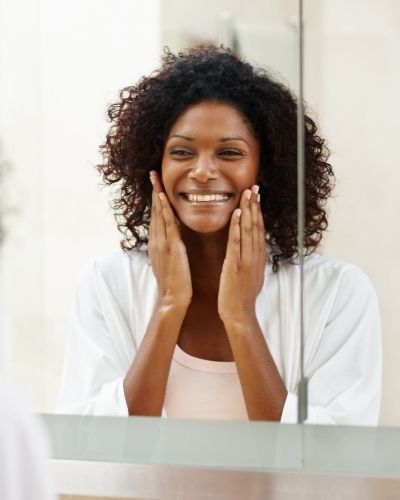Peeling skin can be caused by many external and internal factors, and while not uncommon, it can be annoying and even uncomfortable to deal with.
Therefore, if peeling skin is a common occurrence for you, or you just recently started experiencing this inconvenience, I’m here to help.
In this article, I will explain what causes peeling skin as well as how to get rid of this pesky condition while preventing future reoccurrences.
Luckily, there are many remedies that will help peeling skin, so all you have to do is read more to find out how to combat this issue.

What’s Causing Your Skin to Peel?
Your skin constantly sheds dead skin cells in a natural process called desquamation, and this shedding process is moving unnoticeably.
However, many times, in the case of an injury, the top layer of our skin starts to shed the dead skin cells in clusters abnormally while forming visible scales.
While this may sound frightening, peeling is totally harmless, and it helps the healing process of a wound, injury, or burn.
Therefore, when your skin starts to peel, this usually means that something happened to cause an injury and trigger this reaction.
Peeling skin can occur as a reaction to several inflammatory injuries or direct damage to the skin.
Here are a few common causes that may be causing your skin to peel:
Environmental Factors
Environmental factors are one of the most common causes of skin peeling, as harsh weather and extreme temperatures can cause significant cell damage and dry out the skin, resulting in dead skin cells falling off in larger numbers than usual.
This can cause the skin to become flaky and irritated, especially in areas around the mouth and forehead, where the skin is thinner.
Here are some environmental factors that may cause skin peeling:
Sunburn
Sunburn is the main example of the most common sign of damage to the epidermis.
Sunburn is a radiation burn caused when the UV rays of sunlight damage the DNA of the skin cells in the upper layers.
Through a complicated chain of reactions, the particles that transmit light from UVA rays interact with the skin and cause damage to its proteins, membranes, and DNA.
On the other hand, the particles that transmit light from UVB rays are absorbed by DNA itself, and that extra energy can cause some of the DNA to link up incorrectly.
Once the cells of the top layer of the skin detect DNA damage, they begin producing molecules to attract immune cells into the skin (this is what I like calling a “desperate call for help.”)
This causes the blood vessels to leak into the spaces between cells and other skin structures, and this extra fluid can lead to swelling, red skin, hot sensation, and painful sensitivity of freshly sunburnt skin.
Immune cell invasion begins while you are still sitting comfortably on the beach, but this increases about an hour after you come in from the sun.
The process peaks 24 to 48 hours later, which is why the redness of a sunburn can keep developing for a couple of days before the skin starts to peel.
Red, irritated, and inflamed skin damaged by the sun will flake off slowly to expose new, healthy skin underneath.
Cold Weather
Harsh winter weather is another environmental factor that can cause your skin to peel as cold air, wind, and low humidity outdoors dry your skin out.
With the humidity in the air dropping, your skin will experience an increase in transepidermal water loss, so it is not uncommon to see flaky, irritated, and peeling skin during the cold months of the year.
Without proper care, dehydrated skin can lead to redness, itchiness, chapping, and cracking, leading to bacterial infections entering through the damaged tissues.
Skin Conditions
Inflammatory skin conditions can be another common cause of peeling skin, as during inflammation, the skin will constantly try to renew itself by shedding old, damaged cells and producing new, healthy cells.
However, unfortunately, if the inflammatory skin condition is not addressed through skincare and lifestyle changes, as well as the appropriate medication in some cases, this cycle won’t stop, and the skin will continue to peel and flake.
Some skin conditions that may cause peeling skin include:
Eczema
Eczema or atopic dermatitis may be a short or long-term condition affecting the skin.
It typically occurs because of a hypersensitivity reaction triggered by the skin’s intolerance to a sensitizer, such as an ingredient or type of fragrance or dye in cosmetics or household products, a metal, or even a particular type of fabric.
This reaction results in inflammation, which leads to redness, itching, and often peeling of the skin.
Certain triggers for eczema may be:
- Cosmetics
- Dyes
- Fabrics
- Rubber
- Detergents or soaps
Psoriasis
Unlike eczema, psoriasis manifests itself on the skin in the form of thick patches of white or silvery scales that often peel and flake.
Psoriasis is a chronic autoimmune condition that results in the overproduction of skin cells that build up into silvery-white scales on the skin and peel uncontrollably.
During a psoriasis cycle, which may last anywhere from a few days to a few weeks, the skin becomes inflamed and red, causing uncomfortable itching, which, if indulged, can contribute to the peeling and flaking.
While there is currently no cure for psoriasis, some topical, light-based, and systemic pharmaceutical treatments can put the condition into remission.
Medical Treatments and Medication
Certain medical treatments that may involve damaging the skin to encourage it to renew itself can also cause peeling skin temporarily.
Some of these include:
Radiation Therapy
Radiation therapy, as well as some chemotherapy drugs, which are often used to treat various forms of cancer, can cause skin reactions similar to sunburn.
The treated area may become red, swollen, and tender, and as the skin heals, it may start to peel.
This is a common side effect known as radiation dermatitis.
It usually resolves within four to six weeks after treatment ends, but taking care of your skin during this period is essential to prevent infection.
Acne Treatments
Many acne treatments, particularly those containing ingredients like benzoyl peroxide, antibiotics, or retinoids such as tretinoin and Accutane, can cause dryness and peeling as they work to unclog pores and reduce inflammation.
This is usually a temporary side effect that resolves itself as your skin adjusts to the medication and can be relieved by using a gentle, skin-soothing moisturizer that will soften the dead skin cells and prevent the new skin from getting irritated.
Anti-Aging Procedures
Anti-aging procedures such as chemical peels, laser resurfacing, and microneedling intentionally damage the outer layer of the skin to stimulate cell turnover and collagen production.
This process can result in peeling as the old skin sheds to reveal the new, healthier skin underneath.
Aftercare is crucial in these procedures, including moisturizing and protecting the skin from the sun to ensure proper healing and avoid complications.
Cosmetics
Cosmetics can cause skin peeling mainly due to being severely drying to the skin or causing irritation, to which the skin will react by trying to get rid of the affected cells by shedding them rapidly.
Here are some ways cosmetic products could be causing peeling skin:
Allergies
Some people may have an allergic reaction to certain ingredients in cosmetic products, leading to skin irritation and peeling.
Fragrances and Preservatives
Many cosmetics contain fragrances and preservatives that can cause allergic reactions in some people, resulting in skin irritation and peeling.
Exfoliants
Overuse of exfoliants, which are designed to remove dead skin cells, can strip the skin of its natural oils, leading to dryness and peeling.
Retinoids
Similarly to exfoliants, retinoids can accelerate cellular turnover, which can cause the dead skin cells on the surface to shed rapidly, resulting in peeling and flaking.
Skin Lightening Creams
Some skin lightening creams containing hydroquinone, a bleaching agent, can cause skin irritation and peeling, especially when used in high concentrations or over a long period.
Chemical Burns
A chemical burn is caused by exposure to a chemical, usually by direct contact with the named chemical or its fumes, and may occur through misuse of products such as those for hair, skin, and nail care.
Peeling from cosmetics can last up to a few weeks, during which time the skin needs to be nourished and protected with barrier-repairing moisturizers and high SPF to prevent further damage and scarring.
How to Stop Peeling Skin?

Treatments for peeling skin are dependent upon the underlying cause; however, it is of utmost importance to discontinue using the product or repeatedly expose yourself to the cause of your peeling skin (for example, sunburn).
Here are several things you could do at home to minimize burning and peeling skin:
Apply Cold Compress
If your skin is starting to peel, applying a cold compress to soothe it is a good idea.
Place a cool, wet compress on your skin for several minutes to soothe irritation and stop peeling.
The goal is to reduce the heat and make your skin feel better; however, do not apply ice directly to your skin, as this may result in frostbite and further irritation.
Take Anti-Inflammatory Pain Relievers
Taking over-the-counter anti-inflammatory pain relievers, such as ibuprofen or naproxen, can help with peeling skin that is sore or painful.
Additionally, anti-inflammatory creams containing naturally soothing ingredients such as Centella Asiatica, chamomile, green tea, arnica, etc., can help reduce inflammation caused by sunburns or extremely harsh weather conditions.
Moisturize
Find a moisturizer that is designed to help with sunburn or peeling skin.
A super-ingredient for peeling skin is definitely aloe vera, as it is made from the natural cactus extract and is effective in soothing irritated skin.
However, avoid using raw aloe vera gel derived directly from a plant on your skin, as the gel itself can sometimes cause further irritation.
Apply Mineral Sunscreen
Applying a mineral, zinc-based sunscreen can protect your skin from further damage and soothe irritation, especially if sun exposure is causing your skin to peel.
Look for a broad-spectrum sunscreen with an SPF of at least 30 and apply it generously before going outdoors.
Remember to reapply every two hours or immediately after swimming or sweating.
Use a Humidifier
A humidifier will maintain moisture in the air, which can help alleviate peeling skin caused by dry air and cold weather.
Additionally, adding moisture to the air in your home can help your skin retain its natural moisture, which will strengthen its barrier and prevent imbalances that may lead to inflammatory skin conditions.
Aim for a humidity level between 30% and 50% for optimal results.
Allow Your Skin to Heal
There is not much you can do once the damage is done, but let your skin heal over the next few days.
Applying a cold compress will relieve the uncomfortable soreness, and using a good, nourishing moisturizer will aid the skin in healing.
Besides this, you must be patient and give it a few days until it peels off.
What Not To Do While Your Skin is Peeling?

If you notice that your skin has started peeling as a reaction to a harsh chemical, sunburn, cold weather, or a skin condition, you should absolutely avoid doing the following things:
Avoid Sun Exposure
Even a short exposure to the sun after your skin starts peeling can lead to a painful and irritating burn.
You can help minimize the discomfort and speed up the healing process by avoiding prolonged sun exposure and always ensuring you have enough sunscreen on.
Avoid Exfoliation
AHAs and BHAs are the holy grail for having smooth and blemish-free skin.
However, when the top layer of your skin is damaged and trying to repair itself, you should temporarily stop using these exfoliating agents, as exfoliation is unnecessary while your skin is peeling.
Additionally, exfoliating your skin while it’s peeling as a result of injury can be uncomfortable and can cause further damage, such as uneven skin tone and scarring.
Avoid Peeling Your Scabs
While it can be incredibly tempting to scratch at it or even satisfying to peel the pieces off, this has the potential to make it much worse.
By peeling it off, you are exposing the new skin underneath to harmful bacteria that can lead to infections and other harmful reactions on your skin.
Avoid Hot Water
Hot water can cause peeling by disrupting the layer of protective lipids on the skin’s surface, leading to moisture evaporating and dehydration.
Therefore, if you are dealing with excessively dry skin that tends to shed, flake, and peel, it’s best to avoid showering or washing your face with scorching hot water and use lukewarm or cold water if possible.
Avoid Heavy Makeup
While it might be tempting to cover up peeling skin with makeup, this can worsen the situation.
Heavy makeup can trap dead skin cells, preventing your skin from naturally exfoliating and slowing down the healing process.
Furthermore, some makeup products, such as powders or cream-based cosmetics that contain drying alcohol and irritating fragrances can further exacerbate skin peeling by oxidizing on its surface and causing a disruption in the skin’s natural moisture balance.
Finally, removing your makeup with wet wipes or micellar water that involves the use of cotton rounds can lead to friction, which will further exacerbate peeling and flaking.
If you must wear makeup, opt for lightweight, tinted moisturizers, and make sure to thoroughly remove them before bed by using softening oils and balms that won’t exacerbate dryness and peeling.
The Best Moisturizers for Peeling Skin
When dealing with peeling skin, using a moisturizer to soften, nourish, and replenish some of that lost hydration is a must.
Here are the five best moisturizers for peeling skin that will instantly soothe irritation and normalize shedding:
La Roche-Posay – Cicaplast Baume B5
The best moisturizer for peeling skin.
The La Roche-Posay Cicaplast Baume B5 is a nourishing moisturizer that helps normalize peeling skin and relieve redness and irritation.
It’s formulated with skin-softening shea butter, barrier-repairing panthenol, and soothing and healing madecassoside that helps repair damaged skin and reduces inflammation.
The reason why the La Roche-Posay Cicaplast Baume B5 is my top choice for the best moisturizer for peeling skin is that the formula is free of irritating fragrance, drying alcohol, and damaging parabens, and is also non-comedogenic, making it suitable for all skin types, including sensitive and acne-prone skin.
First Aid Beauty – Ultra Repair Cream
Best for dry skin prone to peeling.
The First Aid Beauty Ultra Repair Cream is a holy grail for those with dry, flaky skin prone to peeling.
It’s formulated with colloidal oatmeal, shea butter, and ceramides that deeply hydrate and soothe dry, irritated skin.
This moisturizer also has the added benefit of helping to restore the skin’s natural barrier function, making it a great option for those dealing with skin peeling due to environmental factors or harsh skincare products.
Vanicream – Daily Facial Moisturizer
Best for sensitive skin prone to peeling.
The Vanicream Daily Facial Moisturizer is a great option for sensitive skin prone to peeling.
It’s formulated with hyaluronic acid and ceramides, which provide long-lasting hydration and repair the skin’s barrier to prevent transepidermal moisture loss and irritation.
Additionally, the rich, nourishing cream is formulated without harsh ingredients such as fragrances, dyes, and parabens, making it suitable for even the most sensitive, reactive, and allergy-prone skin types.
Cetaphil – Daily Hydrating Lotion
Best moisturizer for combination and oily skin prone to peeling.
The Cetaphil Daily Hydrating Lotion is a lightweight, non-greasy moisturizer that is perfect for combination and oily skin types prone to flaking and peeling.
It’s formulated with hyaluronic acid, glycerin, and vitamin E that work together to provide long-lasting hydration and nourishment without clogging pores or feeling heavy on the skin.
Additionally, it’s fragrance-free and suitable for all skin types, making it an excellent option for those with sensitive or reactive skin types.
SkinCeuticals – Triple Lipid Restore 2:4:2
Best anti-aging moisturizer for peeling skin.
The SkinCeuticals Triple Lipid Restore 2:4:2 is a luxurious, anti-aging moisturizer that is perfect for those dealing with peeling skin as well as signs of aging.
It’s formulated with a unique blend of lipids, including ceramides, cholesterol, and fatty acids, in the ideal ratio to restore the skin’s natural barrier function and lock in moisture.
Additionally, it’s enriched with antioxidants to protect the skin from environmental damage and improve the appearance of fine lines and wrinkles.
Overall, this moisturizer will not only soothe peeling skin but also help improve its texture, tone, and overall health.

My name is Simone and I am a certified skin specialist. I created this website to teach my readers how to take great care of their skin and I also like to occasionally share my honest opinions on skincare products I’ve tried. You can learn more about me here.
